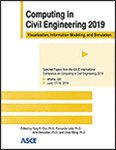ASCE International Conference on Computing in Civil Engineering 2019
Exploiting Music and Dance Notation to Improve Visualization of Data in BIM
Publication: Computing in Civil Engineering 2019: Visualization, Information Modeling, and Simulation
ABSTRACT
Suboptimal information sharing is a key a factor that negatively impacts the construction sector’s massive productivity gap when compared to other sectors of the economy. This is due to management difficulties, supply chain issues, and rework. Building information modeling has been shown to improve dissemination of information but has not yet been exploited to its full potential. In this paper, we propose a new notation for visualizing project information in a BIM context. It is inspired by music and dance notation, and is designed to overcome current limitations that may cause the technology’s limited use during the construction phase. A proof of concept was implemented and tested in an experiment with stakeholders. The use of the proposed BIM notations appeared to make access to and interpretation of available data more effective and resulted in more correct responses.
Get full access to this article
View all available purchase options and get full access to this chapter.
REFERENCES
Akinci, B., Fischer, M. & Kunz, J., 2002. Automated Generation of Work Spaces Required by Construction Activities. Journal of Construction Engineering and Management, 128(4), pp.306–315.
Ballard, G. & Tommelein, I., 2016. Current Process Benchmark for the Last Planner ® System. Lean Construction Journal, 89, pp.57–89.
Baloyi, L. & Bekker, M., 2011. Causes of construction cost and time overruns : The 2010 FIFA World Cup stadia in South Africa. Acta Structilia, 18(1), pp.51–67.
van Beveren, I., 2012. Total factor productivity estimation: A practical review. Journal of Economic Surveys, 26(1), pp.98–128.
Bryde, D., Broquetas, M. & Volm, J.M., 2013. The project benefits of building information modelling (BIM). International Journal of Project Management, 31(7), pp.971–980.
Construction Industry Institute, 2014. The Construction Productivity Handbook, Austin, Texas.
Eadie, R. et al., 2013. BIM implementation throughout the UK construction project lifecycle: An analysis. Automation in Construction, 36, pp.145–151.
Frandson, A. & Tommelein, I.D., 2014. Development of a takt-time plan: a case study. In Construction Research Congress 2014. pp. 1646–1655.
Horman, M.J. & Kenley, R., 2005. Quantifying Levels of Wasted Time in Construction with Meta-Analysis. Journal of Construction Engineering and Management, 131(January), pp.52–61.
Hutchinson Guest, A., 1990. Dance Notation. Perspecta, 26, pp.203–214.
Josephson, P.-E., Larsson, B. & Li, H., 2002. Illustrative Benchmarking Rework and Rework Costs in Swedish Construction Industry. Journal of Management in Engineering, 18(2), pp.76–83.
Lather, J.I., 2016. An Ontology for Interactive Workspaces and Their Use Cases Within Collaborative Design and Construction Practices. The Pennsylvania State University.
Lei, H. et al., 2017. A statistical analysis of the effects of Scrum and Kanban on software development projects. Robotics and Computer-Integrated Manufacturing, 43, pp.59–67.
McLachlan, N.M. et al., 2010. Using spatial manipulation to examine interactions between visual and auditory encoding of pitch and time. Frontiers in Psychology, 1(DEC).
Olawale, Y.A. & Sun, M., 2010. Cost and time control of construction projects: Inhibiting factors and mitigating measures in practice. Construction Management and Economics, (28), pp.509–526.
Piaszczyk, C., 2011. Model Based Systems Engineering with Department of Defense Architectural Framework. Systems Engineering, 14(3), pp.305–326.
Picard, H.E., 2004. Driving Down Construction Project Labor Cost. Construction Management Association of America, pp.1–10.
Ragni, M. & Knauff, M., 2013. A theory and a computational model of spatial reasoning with preferred mental models. Psychological review, 120(3), pp.561–88.
Rosser, L. et al., 2014. Systems Engineering for Software Intensive Projects Using Agile Methods, Garland, TX.
Sacks, R., Radosavljevic, M. & Barak, R., 2010. Requirements for building information modeling based lean production management systems for construction. Automation in Construction, 19(5), pp.641–655.
Teicholz, P.M., 2013. Labor-productivity declines in the construction industry: causes and remedies (a second look). AECbytes, 1(67).
Vrijhoef, R. & Koskela, L., 2000. The four roles of supply chain management in construction. European Journal of Purchasing & Supply Management, 6(3–4), pp.169–178.
Weber, S.F. & Lippiatt, B.C., 1983. Productivity Measurement for the Construction Industry, Washington, DC.
Wilke, L. et al., 2005. From dance notation to human animation: The LabanDancer project. Computer Animation and Virtual Worlds, 16(3–4), pp.201–211.
Information & Authors
Information
Published In
Computing in Civil Engineering 2019: Visualization, Information Modeling, and Simulation
Pages: 295 - 302
Editors: Yong K. Cho, Ph.D., Georgia Institute of Technology, Fernanda Leite, Ph.D., University of Texas at Austin, Amir Behzadan, Ph.D., Texas A&M University, and Chao Wang, Ph.D., Louisiana State University
ISBN (Online): 978-0-7844-8242-1
Copyright
© 2019 American Society of Civil Engineers.
History
Published online: Jun 13, 2019
Authors
Metrics & Citations
Metrics
Citations
Download citation
If you have the appropriate software installed, you can download article citation data to the citation manager of your choice. Simply select your manager software from the list below and click Download.
